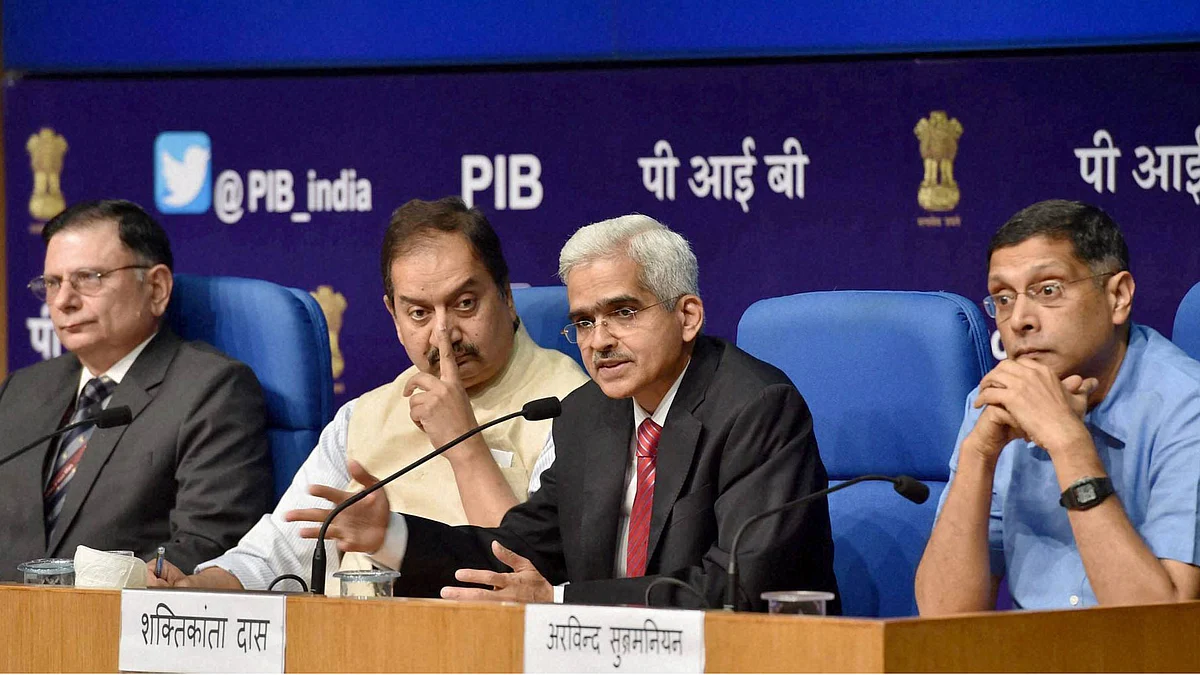RBI Cuts Repo Rate to 5.75%, GDP Projection Adjusted to 7%
The stance has been changed from “neutral” to “accommodative”.

advertisement
The Reserve Bank of India cut the repo rate by 25 basis points to 5.75 percent on Thursday, 6 June. The reverse repo rate and the bank rate have been adjusted at 5.50 and 6 percent respectively.
The stance has been changed from "neutral" to "accommodative" and the GDP growth forecast for 2019-20 has been adjusted to 7 percent from 7.2 percent in earlier projection.
Meanwhile, the inflation outlook has been projected at 3-3.1 percent in the first half of 2019-20 (April-September), and 3.4-3.7 percent in the second half.
Addressing the media after the rate cut was announced, RBI Governor Shaktikanta Das said the central bank "will not hesitate to take any measure which is required to maintain the financial stability of the system, including short-term, medium-term and long-term."
The Monetary Policy Committee (MPC) voted unanimously (6-0) in favour of the rate cut and the change in stance.
The central bank has also decided to do away with charges levied on RTGS and NEFT transactions, with the banks required to pass this benefit to their customers.
It has also been decided to set up a a committee, involving all stakeholders, under the chairmanship of the CEO of Indian Banks' Association (IBA), to examine the entire gamut of ATM charges and fees. The committee will submit its recommendations within two months of its first meeting, reported ANI.
The central bank had cut the short-term lending rate (repo rate) by 25 basis points each in its last two policy reviews too.
Domestic equity benchmarks BSE Sensex and NSE Nifty had opened on a cautious note on Thursday as investors awaited RBI's monetary policy decision.
The 30-share index had been trading 31.03 points, or 0.08 percent, lower at 40,052.51, and the broader Nifty had slipped 18.20 points, or 0.15 percent, to 12,003.45.
Meanwhile, the rupee had slipped 19 paise to 69.45 versus the US dollar in early trade ahead of the RBI policy outcome.
Rising Growth Concerns Prompted Rate Cut: Das
The third successive rate cut is a "decisive and timely" move to address the rising growth concerns, and a rate hike is off the table for now with the shift to an "accommodative" stance, RBI Governor Das said, as per PTI.
The governor also said liquidity – where a deficit had been bothering the financial system for nearly a year – is in surplus now, and he vowed to ensure there is enough liquidity for every productive purpose.
To a specific question on the change in stance from "neutral" to "accommodative", Das said it means that there will not be any rate hike from here on.
"The accommodative stance would basically mean that a rate increase is off the table," Das said, but was quick to clarify that it does not necessarily mean more rate cuts are in the offing.
‘Normal Monsoon Forecasted This Fiscal’
On what would be RBI's priority in case of a poor monsoon, when it comes to propping up growth or fighting inflation, he parried a direct answer saying the weatherman is forecasting a normal monsoon.
He also said the buffer stocks are 3.4 times the food requirement of the nation, seeking to hint that inflation may not rise because of poor rainfalls.
Das refused to spell out what is the real rate of interest – the difference between the headline inflation and the lending rate – and asked everybody to guess for themselves as to how the central bank is narrowing the gap.
In a departure from the past, Das seemed to be appreciative of banks on transmission, but expected a "higher and faster" transmission from here on.
He asserted state development loans, where retail investors are allowed now, are not risky bets at all and carry sovereign backing making it a safe instrument.
Bankers, Financial Players Hail Repo Rate Cut
Banking and finance experts hailed the RBI's decision to cut the short-term lending rate, terming it as a step in right direction that could help stimulate consumer demand, reported PTI.
"The policy was very positive and was reinforced by unanimous voting and the change in stance to accommodative. The statement's focus on supporting growth and bolstering private investment as long as inflation remains within the mandate, is also encouraging and leads us to believe that more accommodation is on the cards," said B Prasanna, Group Head of Global Markets, Sales, Trading and Research at ICICI Bank.
Mahindra Group CFO, VS Parthasarathy said while the rate cut and stance is good, the transmission and execution will make it great and help the country to rise.
"Banking and NBFC are the backbone of the country which need to be nursed back to health. Liquidity is the blood in the veins of this country," Parthasarathy said.
New NPA Resolution Norms to Be Issued Within 3-4 Days: Das
The Reserve Bank will issue a new set of guidelines for bad loan resolution, replacing the 12 February circular that was quashed by the Supreme Court, "within the next three-four days", RBI governor Das said, according to PTI.
The apex court had on 2 April struck down the stringent RBI circular, issued on 12 February 2018, for resolving bad loans under which a company could be labelled an NPA if it missed repayment for a day banks were asked to find a resolution within 180 days or else it should be sent to bankruptcy courts. But the Supreme Court had declared the circular "ultra vires".
Under the 12 February framework, banks were asked to disclose defaults even of a day and find a resolution plan within 180 days in case of large account of Rs 2,000 crore and above failing which it would be send for bankruptcy.
(With inputs from PTI and ANI)
(At The Quint, we question everything. Play an active role in shaping our journalism by becoming a member today.)